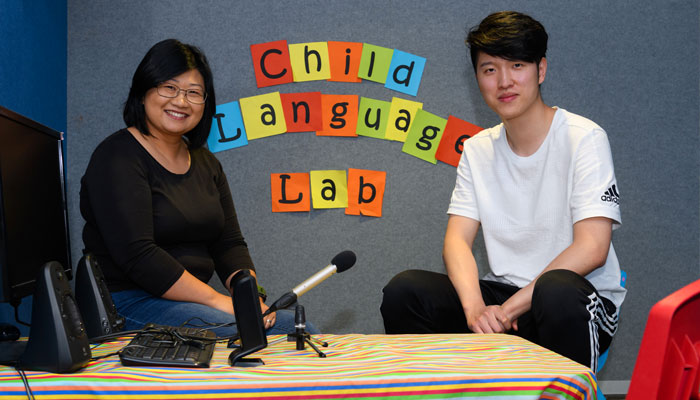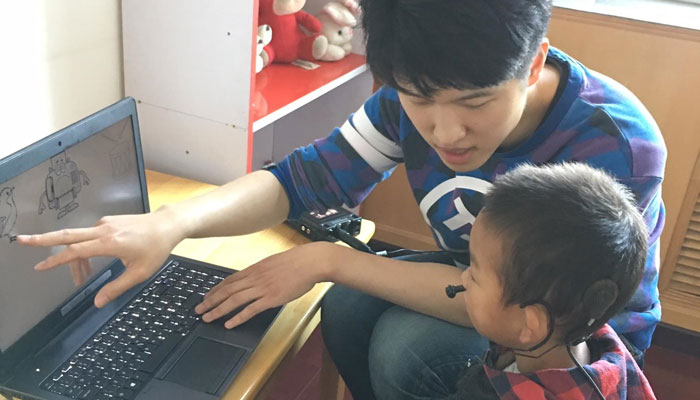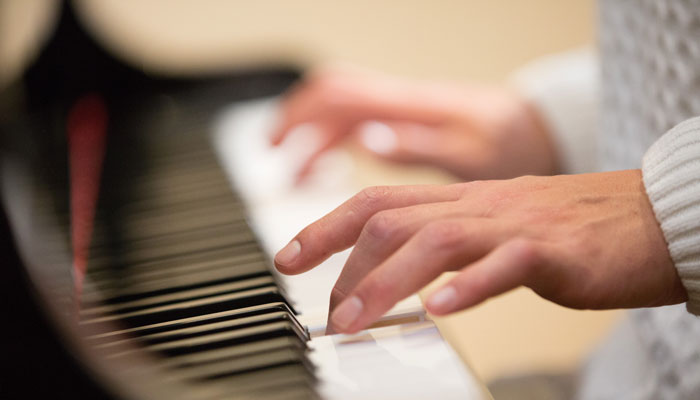First published 22 November 2018
Millions of children with profound hearing loss across the world could be helped by new research under way at Macquarie’s Child Language Lab into the way that Mandarin speakers adjust to Cochlear implants.

Award winners: Dr Nan Xu Rattanasone and PhD candidate Ping Tang.
In Australia, children born with profound hearing loss are usually identified early because of routine newborn screening – and today, they are very likely to have a Cochlear implant before their first birthday to ensure they don’t miss out on those crucial early years of language acquisition.
But English doesn’t rely on different tones in the way we pronounce words to convey their meanings – unlike more than 60 per cent of the world’s languages (including Mandarin, Thai, Vietnamese and Navajo).
For children born into a society where their primary language is tonal, early identification of hearing loss and access to sound may be even more important.
- National screening program will test Aussie kids for hearing loss
- Big events trigger a rise in hearing loss
Much of the research on language acquisition focuses on non-tonal languages, such as English; but many of the world’s biggest populations – in China, south-east Asia and sub-Saharan Africa – speak a tonal language.
Two researchers at Macquarie’s Child Language Lab, Dr Nan Xu Rattanasone and PhD candidate Ping Tang, were last month awarded the Dr Li Sze Lim Mobility Scholarship which will allow them to build on their earlier research into this topic.
Ping also won both the Diversity Enhancement Award and the Best Student Paper Award this month at the prestigious Boston University Conference on Language Development, held in the United States.
Ping will travel to Beijing next year to compare language skills in children with hearing loss and how that varies by the age they received a Cochlear implant.
Importance of implants before age two
Their project builds on the HearingCRC-funded research that Ping had already done, working with Dr Rattanasone, Dr Ivan Yuen and Distinguished Professor Katherine Demuth. Ping had personally tested language skills in 72 children with cochlear implants in Beijing, aged 3-7 years, and a further 120 hearing children aged 3-5 years and 44 hearing adults.
We know that the brain shows less plasticity after a certain age to be able to acquire new sounds in a native way.
He developed a game-like test that could be used by pre-schoolers and worked with Professor Liqun Gao at Beijing Language and Culture University in China.
The project could have big implications for the estimated 4.6 million children with profound hearing loss in China, as well as implications for hearing-impaired children around the world learning tonal languages.
Mandarin Chinese typically has four ‘tones’ which are important to signify a word meaning. For example, the word ‘ma’ can mean either mother, hemp, horse or scold, depending on the tone.

Earlier the better: Ping Tang at work testing the language skills of children with cochlear implants in Beijing.
The different tones can be described as a high level tone, a rising tone, a dipping tone and a falling tone.
“In Mandarin, when speaking in natural, connected speech, these tones have a lot of changes – and so in order to speak naturally themselves, children also need to learn this tone change phenomenon,” Ping explains.
“Our work has focused on language acquisition, not only focusing on those four lexical tones, but also on this tone changing phenomenon.”
Children develop tones in single words very early, he adds.
“Previous studies only looked at children's acquisition of the four tones in single words, but in Beijing last year we studied the four tones and the tone changes in connected speech,” he says.
“We found that children who were implanted before age two can acquire both lexical tones and tone changes in connected speech. But for children who were implanted after age two, they couldn’t produce accurate tones.”
That poor use of tone continued for a number of years, he added.
Nan points out that it’s too early to tell if that tonal incapacity is fixed, as children in the study had only been implanted between one and five years. There were also some concerns about the way that language had been taught to children in the hearing impaired group – that is, using distinct words rather than connected speech.
“We know that the brain shows less plasticity after a certain age to be able to acquire new sounds in a native way and we think that is just before puberty, so around 7 to 12,” she says.
Our results suggest that it's really important to get implantation early, even more so for tonal languages.
But in Ping’s findings, children were much younger than previous studies indicated could be an issue for language acquisition.
“We really need to do lots more studies in this area to help tease apart the impact of not hearing a good signal, from the brain's natural maturational effects on acquiring tone,” Nan says.
“Our results suggest that it's really important to get implantation early, even more so for tonal languages,” Ping says.
Only one-third of children implanted before age three
Newborn hearing screening happens in some of China’s largest cities but isn’t routine across the nation, Ping says.
Only around five per cent of children with hearing loss receive a Cochlear implant in their first year of life, and only a third of children are implanted before age three. “Our early results suggest that is already very late to acquire tones,” he says.
He also noticed that many language teachers would teach words, syllable by syllable, to improve the clarity of tones – but says that won’t help children learn to produce connected speech, which is what is used for daily communication.
He hopes that their work will be able to support evidence-based recommendations regarding age of implantation guidelines for children learning tonal languages. These recommendations might also inform clinical practitioners, teachers and parents, he says.
Dr Nan Xu Rattanasone is a Research Fellow in the Department of Linguistics.



